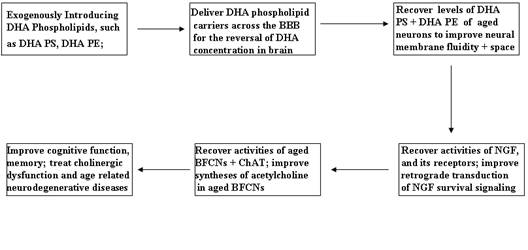Proposed etiology of Alzheimerí»s disease
The etiology of Alzheimerí»s disease (AD) is still not well understood. The prevailing hypothesis is that the brain overproduces or fails to degrade an endogenously produced 42 amino acid-length peptide known as amyloid-beta (AŽ┬)(see below).

In approximately 5% of cases, there is a genetic cause for overproduction of AŽ┬, but for the 95% of sporadic sufferers, there is no answer as to why they develop the AD.
It has been demonstrated that when AŽ┬ is aggregated into oligomers, it become toxic, causing inhibition of synaptic activity as well as neuronal and neuritic degeneration. Further aggregation of AŽ┬ leads to extracellular deposits known as amyloid plaques (see above picture A).
Cholinergic hypothesis of Alzheimerí»s disease
Alzheimerí»s disease has been found to be markedly reduced at least 40%, compared with controls, of choline acetyltransferase activity and acetylcholine synthesis. One of the persisting hypotheses of the AD mechanism underpinning the memory decline in AD involves the degeneration of the basal forebrain cholinergic neurons (BFCNs) where an important neurotransmitter acetylcholine is mainly synthesized. There is a strong correlation between the regions of the brain where AŽ┬ generation and plaque load are high (see above picture A), such as the hippocampal formation and the cortex. Therefore, changes to neurotransmission within this circuitry are likely to underpin the cognitive decline observed in AD.
Although there are various drugs for the AD, the only classes of the drugs with clear efficacy in clinical trials are those targeting the cholinergic system. The following scheme shows the pathway of biosynthesis and metabolism of an important neurotransmitter acetylcholine in neurons:

The therapeutic mechanism of the cholinergic drugs in treatment of age-dependent cholinergic dysfunction related neurodegenerative disorders is to increase brain acetylcholine concentration by inhibiting acetylcholinesterase activity leading to blocking further degradation of the neurotransmitter in neurons.
Maintenance of the neural membrane and neuroprotection against Alzheimerí»s disease
The maintenance of normal levels of neural membrane DHA phospholipid species is essential for keeping normal membrane function. Continuous supply of DHA into the aged brain and the unique metabolism of DHA in relation to its incorporation into neural membrane aminophospholipids (phosphatidylserine (PS) and phosphatidylethanolamine (PE)) plays an important role in promoting both membrane fluidity and gap junction coupling capacity because the study strongly suggests that age-dependent cholinergic neurodegeneration may be a treatable disorder of failed retrograde the nerve growth factor (NGF) signaling. The reversal of DHA-PS and DHA-PE molecular species present in the inner plasma membrane leaflet could lead to recovering the normal expression of neurotrophin receptors and effective retrograde transport of NGF from the hippocampus to the basal forebrain and appear to contribute to the recruitment of NGF signaling in neurons, resulting in promoting the choline acetyltransferase (ChAT) activity in the basal forebrain cholinergic neurons (BFCNs) where an important neurotransmitter acetylcholine is mainly synthesized. Because it has reported that both the ChAT activity and acetylcholine synthesis are associated with the expression of the p-75 neurotrophin receptor in patients with age-dependent neurodegenerative disorders.
Pharmacological effects of DHA ĘC containing phospholipids






